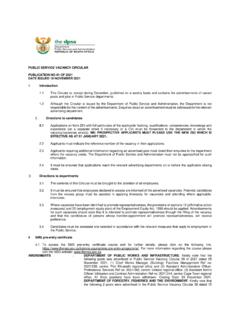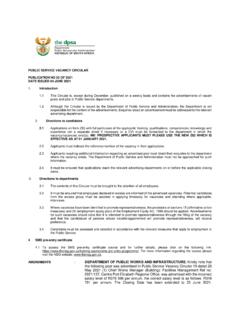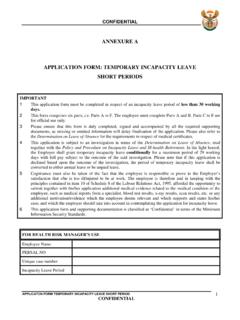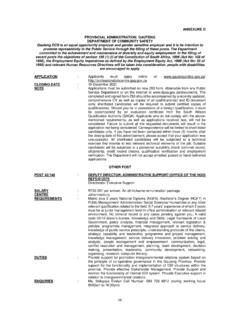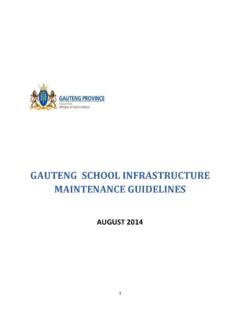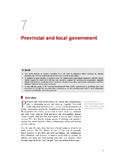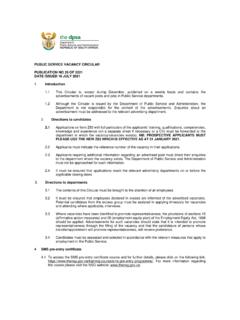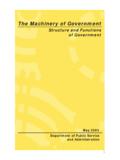Transcription of Handbook for Teachers’ Rights, - SACE
1 The Teacher s Handbook i Handbook for Teachers Rights, Responsibilities and Safety Produced by LeadAfrika Consulting (Pty) Ltd South Africa The Teacher s Handbook ii AUTHORSHIP Welcome to the Handbook on Teachers Rights, Responsibilities and Safety. This book was written by LeadAfrika Consulting (Pty) Ltd, in conjunction with the South African Council for Educators (SACE). On 5 March, SACE launched the National Teacher Rights, Responsibility and Safety Programme in Pretoria, where it was decided that from the mandate that was given by the department of Basic education , SACE should try to find out what they could do nationally to assist the teacher to be safe in schools. SACE decided to create a Handbook that teachers could use within a classroom and school situation when confronted by the behaviour displayed by children that is abusive and aggressive.
2 The Handbook provides various do s and don ts that teachers should be aware of when they are confronted by learner-on-teacher school-based violence. In preparation of this Handbook LeadAfrika Consulting used: i. Current literature to establish best practises from an international context as well as an African context; as well as to identify cutting edge innovations in the space of learner on teacher school-based violence; teacher rights as espoused in various documents; teacher protection within the violence-based context and teacher rights and responsibilities. ii. Other sources of information including internet websites, legislation, department of education reports and documents; and research books and journal articles; iii.
3 The report of empirical research that was done by LeadAfrika Consulting to solicit educators views on learner on teacher school-based violence in South Africa by holding focus group discussions in all the nine provinces of the country; and iv. Other relevant information (such as, lessons from other professional teaching councils and national councils outside the teaching profession) as background information in preparation of developing the SACE Handbook /guide of teachers rights, responsibilities and safety. ACKNOWLEDGEMENTS The funding of this Handbook was provided by the South African Council for Educators (SACE). A big thank you to SACE and Ms Ella Mokgalane, the CEO as well as Ms Tuzana Sophethe, the project leader.
4 The Teacher s Handbook iii The authors acknowledge with gratitude all the educators who made a major contribution to this Handbook . Educators from across the country as well as union and departmental officials were involved in focus group interviews and this provided the researchers with scenarios being experienced in schools in South Africa. These scenarios have been used in the compilation of this Handbook . The draft Handbook was workshopped with a group of educators from various schools. We also gratefully acknowledge the department of Basic education officials who provided valuable input into the development of this Handbook . In addition, we acknowledge the use of newspaper articles from the Sunday Times and Hnek Kruger/Cape Argus.
5 Last but not least, we gratefully acknowledge Miss Mareli van der Westhuizen of Lyttelton Manor High School for the creative art represented in this Handbook . The Teacher s Handbook iv CONTENTS Handbook for Teachers Rights, Responsibilities and Safety .. i AUTHORSHIP .. ii ACKNOWLEDGEMENTS .. ii ACRONYMS .. v DEFINITIONS .. vi CHAPTER 1: INTRODUCTION AND BACKGROUND .. 1 HOW SHOULD THIS Handbook BE USED? .. 1 LITERATURE REVIEW .. 2 Introduction .. 2 Learner on Teacher School-Based Violence .. 3 EMPIRICAL RESEARCH .. 4 Introduction .. 4 Teachers Rights .. 5 Teachers Responsibilities .. 7 Teachers Safety .. 10 Roles of educators, HODs, principals, community leaders and parents in the local level crime and violence prevention in the school.
6 13 Conclusion and Recommendations .. 14 Suggested Framework for Teachers Safety in Schools .. 18 CHAPTER 2: SCENARIOS AND DO S AND DON TS IN SCHOOL VIOLENT SITUATIONS .. 20 INTRODUCTION .. 20 Case Study .. 22 CLASSROOM VIOLENT ACTIVITIES .. 25 Physical, Sexual and geneder-based violence .. 25 Emotional/verbal violence .. 36 Psychological violence .. 37 Common challenges that may lead to violence .. 54 SCHOOL LEVEL VIOLENCE .. 75 Physical violence .. 75 Verbal/Emotional Violent Activities .. 97 COMMUNITY LEVEL .. 108 BIBLIOGRAPHY .. 117 The Teacher s Handbook v ACRONYMS ADHD Attention Deficit/Hyperactivity Disorder Articulate Teachers Program BGEM Boy, Girls education Movement CCMA Commission for Conciliation, Mediation and Arbitration COSAS Congress of South African Students CHH Child Headed Households CPF Community Policing Forum DBE department of Basic education CPF Community Police Forum EAP Employee Assistance Programmes EEA Employment of Educators Act HOD Head of department HSRC Human Sciences Research Council IPID Independent Police Investigative Directorate LRA Labour Relations Act Life Orientation MEC Member of the Executive Council.
7 NGO Non-government Organisation PTSD Post-Traumatic Stress Disorder PAM Personnel administration Measures QLTC Quality Learning and Teaching Campaign SBST School Based Support Team SACE South African Council for Educators SAPS South African Police Services SGB School Governing Body SMT School Management Team YMF Youth Management Foundation The Teacher s Handbook vi DEFINITIONS Expulsion is the permanent prohibition by the Head of the respective provincial education department of a learner from attending the school concerned if found guilty of serious misconduct. Suspension, refers to the temporary prohibition by the governing body of a learner from attending school. Serious misconduct is a set of behavioural norms which a learner at a school shall be found guilty of if he/she transgresses the school's code of conduct.
8 The "code of conduct" is a statement of behavioural norms compiled in terms of the South African Schools Act, Act , 1996, to regulate the conduct of learners attending a public school. An educator/teacher as defined by the Educators Employment Act 1994, is any person who is appointed to exclusively perform extracurricular duties, who teaches, educates or trains other persons or who provides professional educational services, including professional therapy and educational psychological services at a school. A parent refers to: the parent or guardian of a learner the person legally entitled to custody of a learner, and the person who undertakes to fulfil the obligations towards the learner's education at school.
9 The Teacher s Handbook 1 CHAPTER 1: INTRODUCTION AND BACKGROUND HOW SHOULD THIS Handbook BE USED? This Handbook consists of two chapters. Chapter 1 introduces the Handbook . Section informs the reader on how the Handbook should be used. Section provides a broad overview of the literature and Section examines the literature on learner on teacher school based violence in South Africa. Section introduces the empirical research, followed by a discussion on Teacher Rights (section ), Responsibilities (section ) and Safety ( ). Section deals with the roles of educators, HODs, principals, community leaders and parents in the local level crime and violence prevention in the school.
10 Section presents the conclusion with suggested recommendations. Section deals with a suggested framework for teachers safety in schools. Chapter two covers various scenarios relating to violent situations in schools and classrooms and also presents some do s and don ts in such scenarios. There are pertinent questions teachers ask themselves without being able to answer them. For , What makes a school a safe place? What can be done? What is the way forward for educators? How is support stakeholder going to help? How can we assist young teachers to manage their classes? How do we empower our teachers not to be able to say, I am feeling that I am not good enough? The learners are no longer respecting, not only their teachers, but also their parents.




